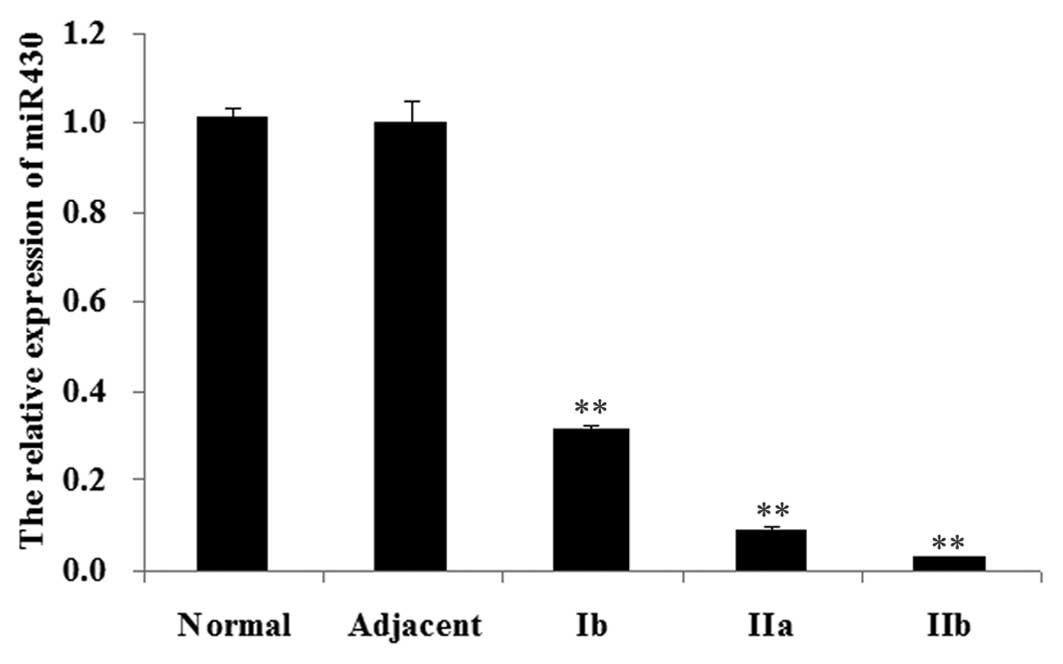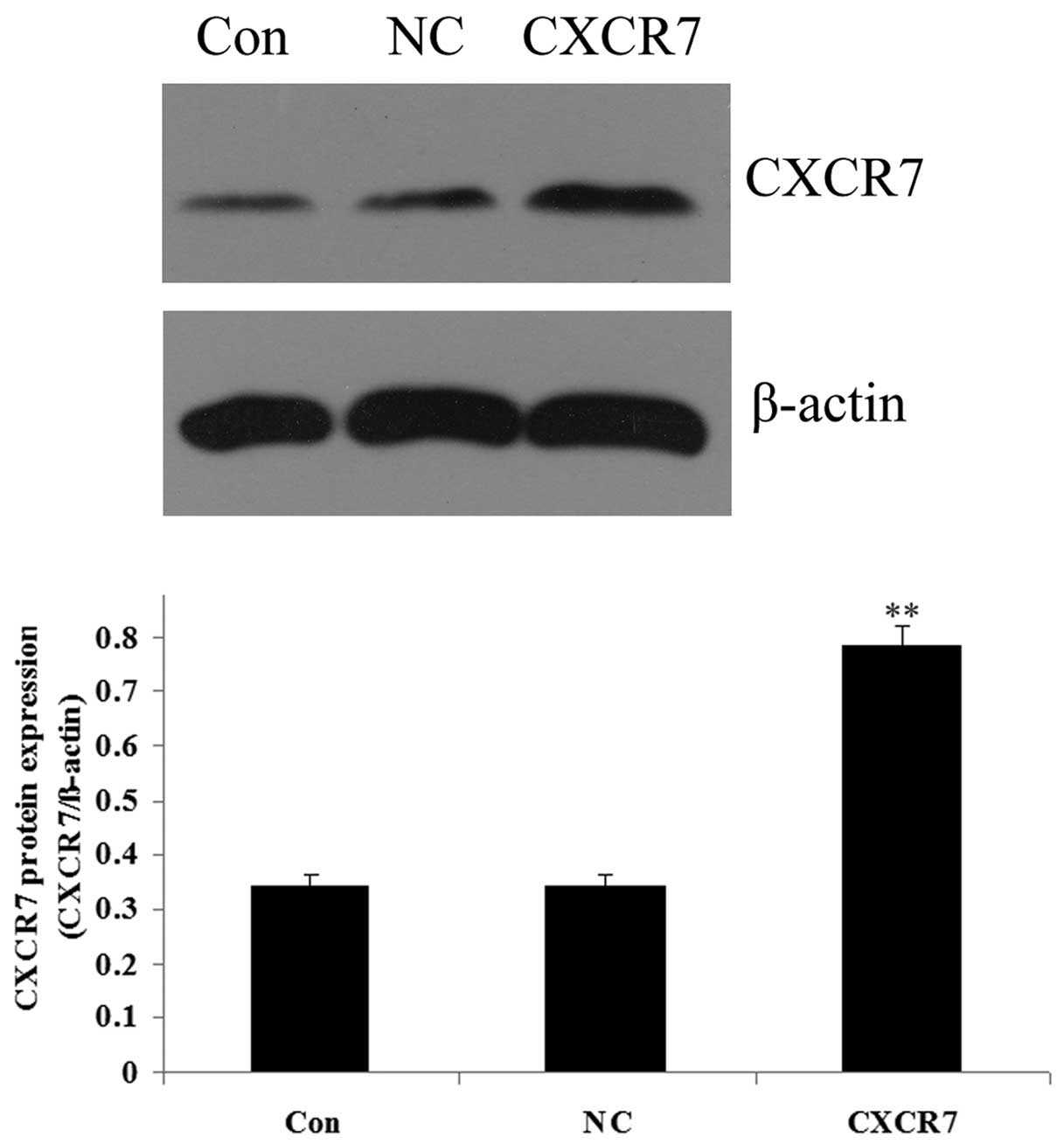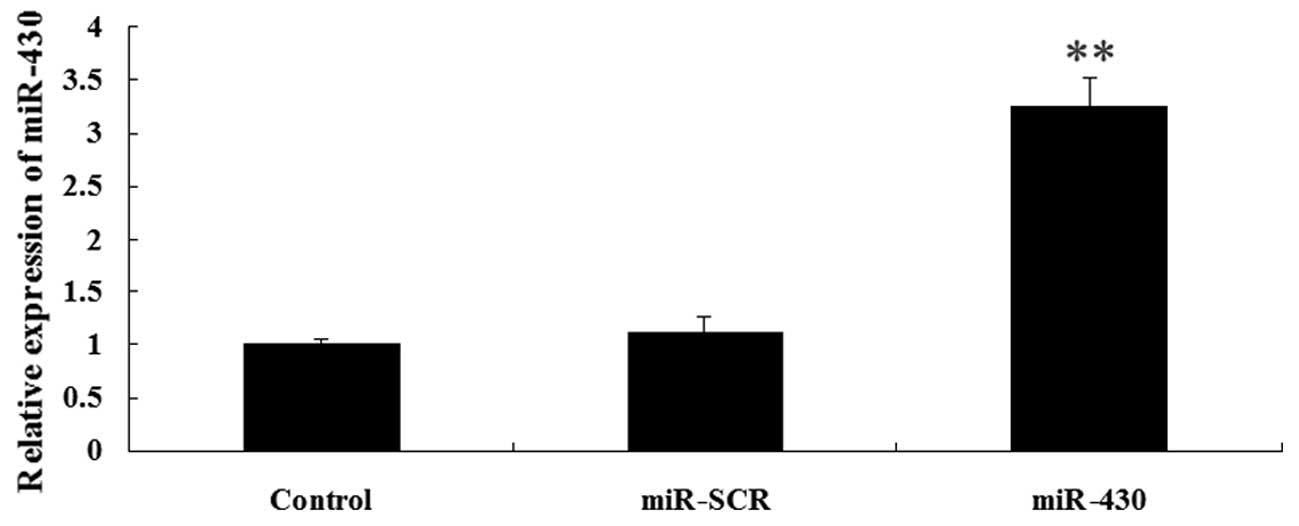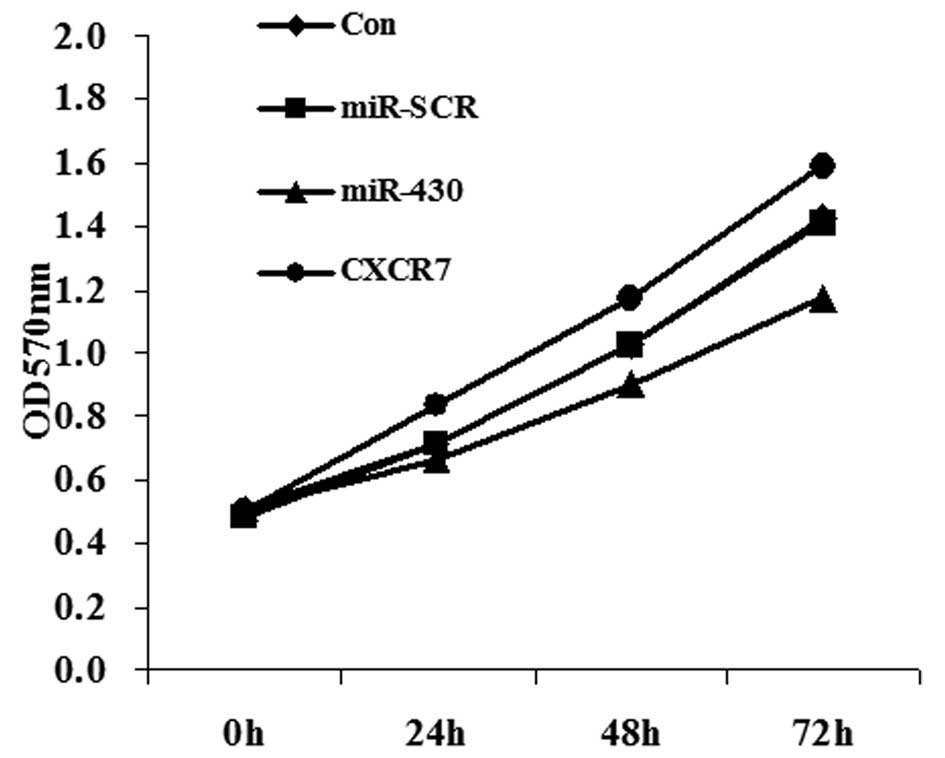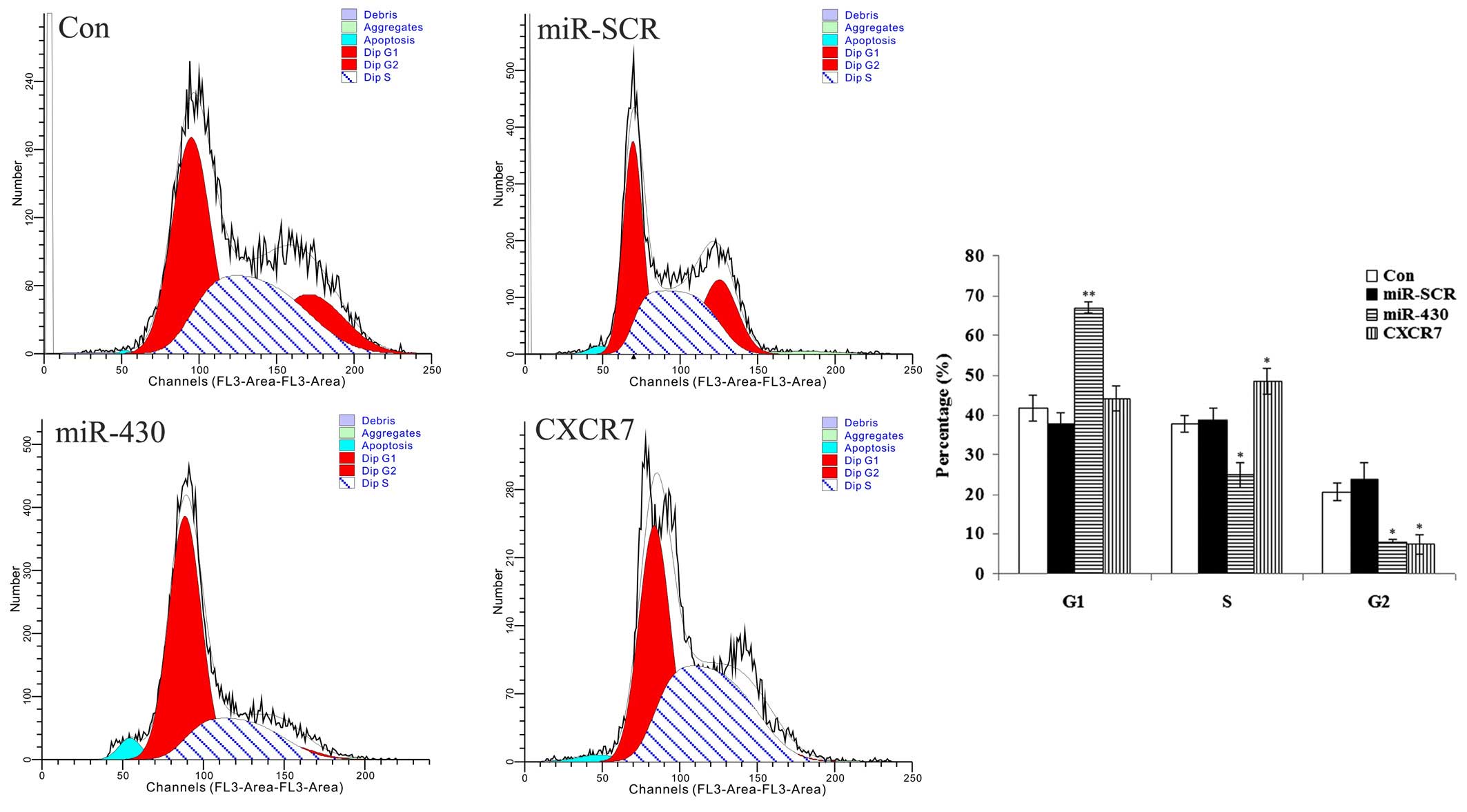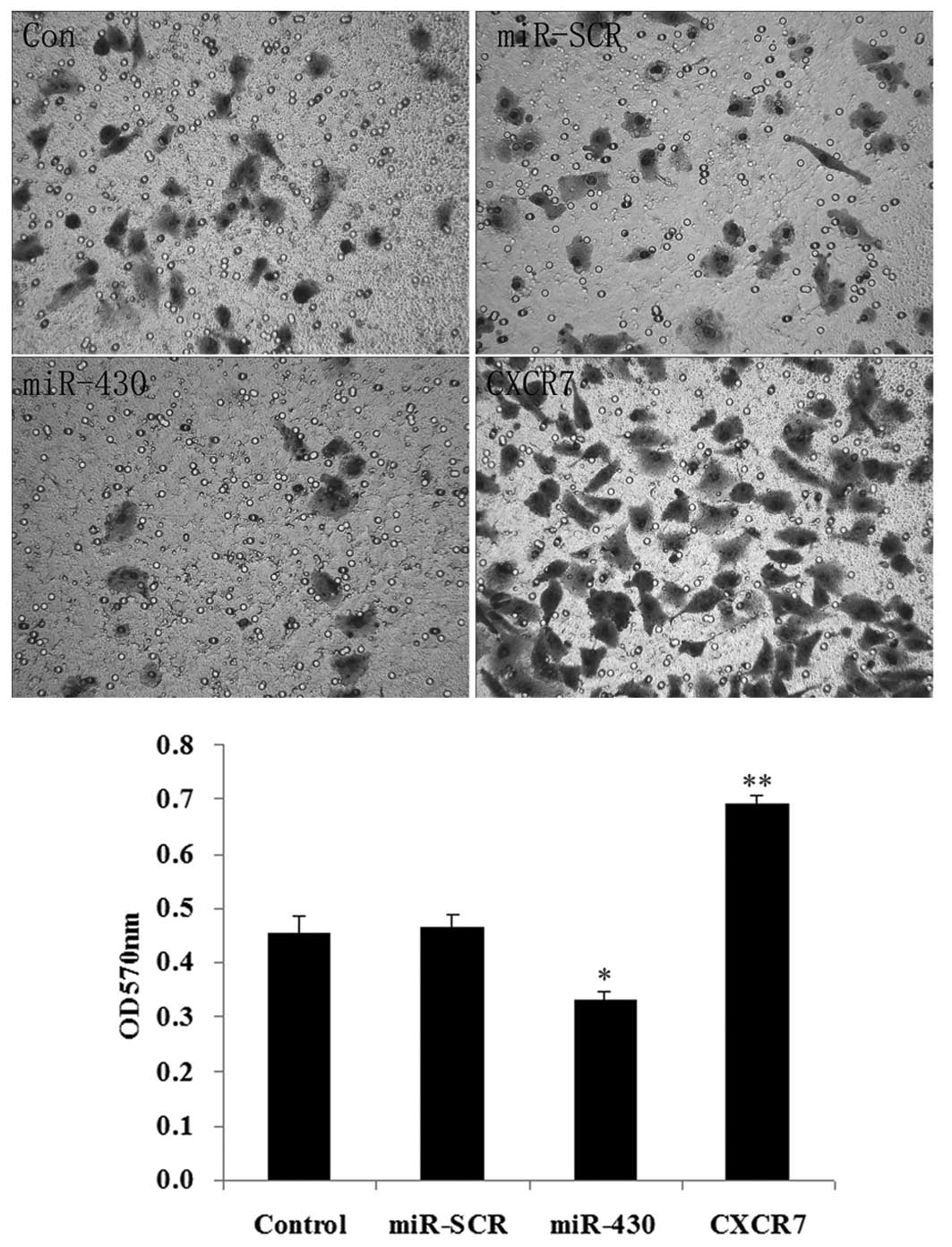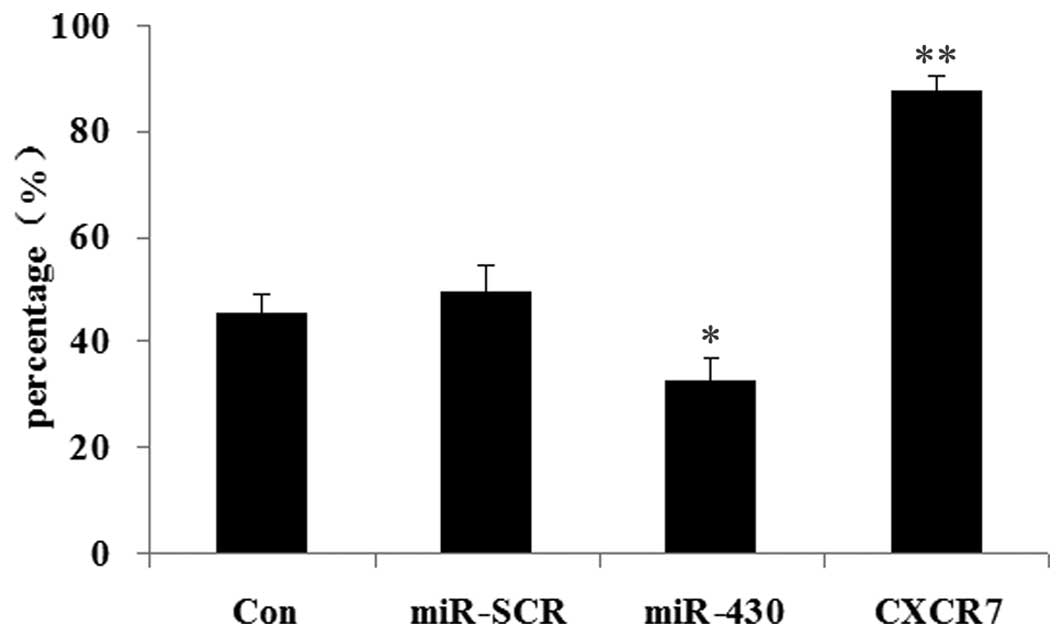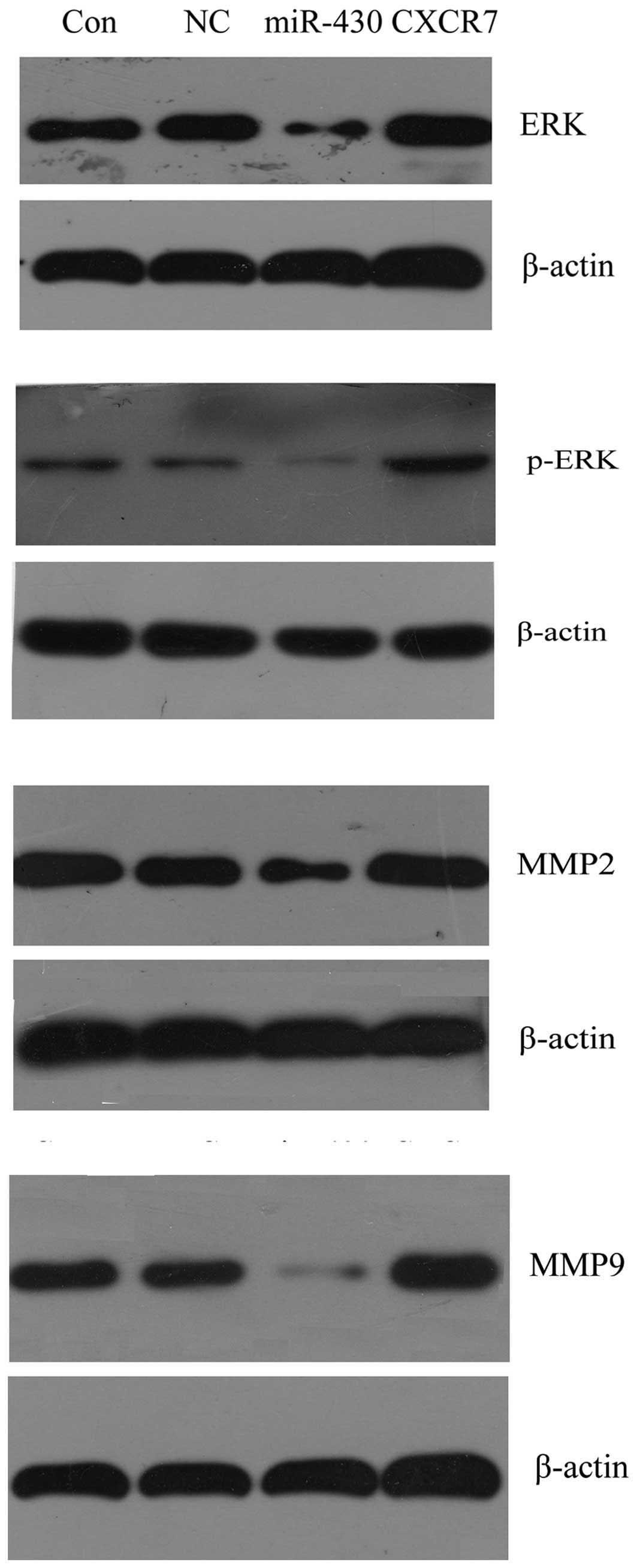Decreased expression of miR-430 promotes the development of bladder cancer via the upregulation of CXCR7
- Authors:
- Published online on: May 16, 2013 https://doi.org/10.3892/mmr.2013.1477
- Pages: 140-146
Abstract
Introduction
Bladder cancer is a common malignant tumor in humans; however, the molecular mechanism underlying its growth and invasion remains unclear. MicroRNAs (miRNAs) are small, endogenous and non-coding RNAs that inhibit gene expression via interaction with target sites in the 3′-untranslational region (UTR) of mRNA (1). Emerging data has shown that miRNAs are important in the regulation of various biological processes, including the development of several types of human cancer (2). miRNA-430 (miR-430) has mainly been investigated in zebrafish and has been shown to be associated with early embryo development (3–5). However, whether miR-430 is involved with the development of malignant tumors has not been reported.
CXCR7 is 7-transmembrane chemokine receptor of the stroma-derived factor-1α (SDF-1α). Its expression has been reported to be enhanced during tumor development, indicating that CXCR7 is an attractive therapeutic target for cancer (6). Yates et al observed that CXCR7 expression was elevated in bladder cancer tissue and was associated with high-grade tumors and metastasis (7). In addition, CXCR7 has been demonstrated to be associated with proliferation, migration and invasion of bladder cancer through several signaling pathways, including ERK, Stat3 and AKT signaling (7,8).
The present study firstly revealed an miR-430 expression pattern in normal bladder, adjacent tissue and bladder cancer tissue. Furthermore, the overexpression of miR-430 in human bladder cancer 5637 cells significantly inhibited cell proliferation, migration and colony formation efficiency. These findings were contrary to those obtained following the overexpression of CXCR7, which was validated to be a direct target of miR-430 in this study. Further analysis showed that cell proliferation- and migration-related genes, including ERK, phosphorylated-ERK (p-ERK), matrix metalloproteinase-2 (MMP-2) and MMP-9, were significantly downregulated in miR-430 overexpressed 5637 cells, while markedly upregulated in CXCR7 overexpressed 5637 cells. Our study reveals a novel role and a potential regulatory mechanism of miR-430 in bladder cancer cells.
Materials and methods
Cell culture
The human bladder carcinoma 5637 cell line was cultured in RPMI-1640 medium with 10% FBS and 1% penicillin/streptomycin at 37°C with 5% CO2. The study was approved by the ethics committee of Second Xiangya Hospital of Central South University, Changsha, China.
RNA extraction and quantitative real-time PCR (qRT-PCR) analysis
TRIzol reagent (Invitrogen Life Technologies, Carlsbad, CA, USA) was used to extract RNA from tissues or the 5637 cell line. The RNA integrity was then assessed. TaqMan qRT-PCR miRNA assay (Applied Biosystems, Carlsbad, CA, USA) was performed to determine the miR-430 expression level. The relative expression of miR-430 was normalized to U6 endogenous control. Each measurement was performed in triplicate. For CXCR7 expression, 1 μg total RNA was reverse transcribed into cDNA using SuperScript™ III First-Strand Synthesis SuperMix (Invitrogen Life Technologies). SYBR Green qRCR Mix (Toyobo, Osaka, Japan) was then used to perform qRT-PCR with the following CXCR7 primers: forward 5′-TGGGTGGTCAGTCTCGT-3′ and reverse 5′-CCGGCAGTAGGTCTCAT-3′. β-actin was used as a control and its primers were as follows: forward 5′-AGGGGCCGGACTCGTCATACT-3′ and reverse 5′-GGCGGCACCACCATGTACCCT-3′.
Western blotting
Cells were solubilized in cold RIPA lysis buffer and then separated with 10% SDS-PAGE. Proteins were then transferred onto a polyvinylidene fluoride (PVDF) membrane. After blocking in 5% nonfat dried milk in PBS for 3 h, the membrane was then incubated overnight with specific antibodies for CXCR7, ERK, p-ERK, MMP-2, MMP-9 and β-actin (Abcam, Cambridge, MA, USA). After incubation with the specific secondary antibody, respectively (Abcam), immune complexes were detected using the enhanced chemiluminescence (ECL) method. The results were visualized by autoradiography using preflashed Kodak XAR film (Kodak, Tokyo, Japan).
Dual luciferase reporter assays
A normal and a mutated 3′-UTR of CXCR7 was subcloned to construct reporter vectors with miRNA-binding sites, which were then inserted into the multiple cloning sites downstream of the luciferase gene in the psiCHECK™-2 luciferase miRNA expression reporter vector. For the luciferase assay, a dual-luciferase reporter assay system (E1910, Promega Corporation, Madison, WI, USA) was used. According to the manufacturer’s instructions, 20,000 cells were cultured in 24-well plates at 37°C with 5% CO2 for 24 h. When cells reached 70–80% confluence, the cells were cotransfected with psiCHECK™-2-CXCR7-3′-UTR or psiCHECK™-2-mut CXCR7-3′-UTR vector using Lipofectamine 2000. miR-430 or miR-430 inhibitor was added, respectively (Table I). The cells were then incubated with transfection reagent/DNA complex for 5 h, and then refreshed with fresh medium containing 10% FBS. A total of 48 h after transfection, firefly and renilla luciferase activities were evaluated using the dual-luciferase reporter assay system (Promega Corporation) and renilla luciferase activity was normalized to firefly luciferase activity.
Plasmid construction and transfection
The plasmids of miR-SCR, miR-430 and CXCR7 were constructed by Aijia Bio (Changsha, Hunan, China). Retroviral supernatants were prepared using Eco-Phoenix packaging cells. The 5673 cells were transfected using 20 mg/ml polybrene for 48 h.
MTT assay
Human bladder cancer 5673 cells were plated at a density of 5,000 cells per well. After adding MTT (Promega Corporation) to the medium at a final concentration of 0.5 μg/ml, 5673 cells were then incubated at 37°C with 5% CO2 for 3 h. The medium was then removed and 100 μl DMSO was added. The plate was gently rotated on an orbital shaker for 10 min to completely dissolve the precipitation. The microplate reader (Bio-Rad, Hercules, CA, USA) was used to determine the absorbance at 570 nm.
Flow cytometric analysis
Flow cytometry was performed in order to determine the cell cycle in all groups. In total, 200,000 cells were washed twice with Dulbecco’s modified phosphate-buffered saline and resuspended in 70% ethanol. After fixation overnight at −20°C, the cells were pelleted, washed twice in 1X PBS with 3% BSA, and pelleted. Subsequently, the cells were resuspended and incubated for 30 min at room temperature in propidium iodide (PI) staining buffer containing 3% BSA, 40 μg/ml PI and 0.2 mg/ml RNase in 1X PBS. DNA content analysis was performed using flow cytometry (FACSCalibur, Beckman Coulter, Miami, FL, USA).
Transwell assay
For all groups, migration was measured in 24-well transwell chambers (Chemicon, Temecula, CA, USA). After 24-h incubation at 37°C with 5% CO2, the migrated cells were stained and counted.
Colony formation assay
A colony formation assay was performed in order to determine the colony formation efficiency of the 5673 cells. In total, 200 cells were added to each well of a 6-well plate, which was then incubated at 37°C for 14 days. The cells were subsequently gently washed and stained with crystal violet. Viable colonies containing ≥50 cells were counted.
Statistical analysis
Data are shown as the mean values ± standard deviation (SD) of at least triplicate determinations. Statistical analysis was performed using SPSS 17.0 statistical software. The statistical significance of the differences was determined by ANOVA. P<0.05 was considered to indicate a statistically significant difference, while P<0.01 was considered to indicate a markedly significant difference.
Results
Expression of miR-430 in normal bladder, adjacent tissue and bladder cancer tissue
We firstly determined the expression of miR-430 in different tissues, including normal bladder tissue, adjacent tissue and bladder cancer tissue of different stages, including Ib, IIa and IIb. As shown in Fig. 1, the miR-430 expression levels in bladder cancer tissue were significantly decreased compared with those in normal tissue and adjacent tissue (P<0.01). Furthermore, among bladder cancer tissue of different stages, the miR-430 expression level in stage Ib was the highest, whereas the miR-430 expression level in stage IIb was the lowest.
CXCR7 is the direct target of miR-430
A luciferase assay was performed to detect whether CXCR7 was the direct target of miR-430. The result demonstrated that the renilla/firefly value of luciferase was significantly decreased only following transfection with the 3′-UTR of the CXCR7 gene in miR-430 treatment cells. However, in other groups, the renilla/firefly value of luciferase showed no difference compared with the control (Fig. 2). These data suggest that CXCR7 was the direct target of miR-430.
Expression of CXCR7 and miR-430 following transfection
As demonstrated in Fig. 3, the results from western blotting showed that the protein level of CXCR7 was significantly increased in the 5637 cells following transfection with the CXCR7 overexpression plasmid compared with the controls (P<0.01). The expression of miR-430 in 5637 cells was upregulated following transfection with miR-430 lentivirus vector compared with the controls (P<0.01; Fig. 4). These data indicated that we successfully constructed the overexpression plasmids of CXCR7 and miR-430, which could then be used in the subsequent experiments.
Effect of miR-430 and CXCR7 overexpression on the proliferation of 5637 cells
Since the miR-430 expression level was lower in bladder cancer tissue and CXCR7 was shown to be a direct target of miR-430, we studied the effects of transfection with miR-430 and CXCR7 on 5637 cell proliferation. MTT data showed that miR-430 significantly inhibited cell proliferation while CXCR7 promoted proliferation of 5367 cells, compared with the controls (Fig. 5).
Effect of miR-430 and CXCR7 overexpression on the cell cycle of 5637 cells
As shown in Fig. 6, the 5637 cells transfected with various plasmids showed differences in the cell cycle. The data demonstrated that the majority of the cells transfected with miR-430 lentiviral vector were in the G1 phase, and the percentage in the S phase was lowest among all groups, indicating that the cell cycle was blocked at the G1 phase. For those cells transfected with the CXCR7 overexpression plasmid, the data showed that the majority of the cells were in the G1 and S phases, and only a few cells were in the G2 phase, indicating that cell division was active. These results suggested that miR-430 suppressed the mitosis of 5637 cells. By contrast, CXCR7 promoted the mitosis of 5637 cells.
Effect of miR-430 and CXCR7 overexpression on the migration of 5637 cells
As shown in Fig. 7, the overexpression of miR-430 had a negative effect on cell migration (P<0.05), while the overexpression of CXCR7 significantly promoted cell migration (P<0.01).
Effect of miR-430 and CXCR7 overexpression on colony formation efficiency of 5637 cells
The effects of CXCR7 and miR-430 on colony formation efficiency were then examined in 5637 cells. As shown in Fig. 8, when compared with the control groups, those 5637 cells overexpressing miR-430 showed the lowest colony formation efficiency (P<0.05). However, the 5637 cells transfected with CXCR7 overexpression plasmid demonstrated the highest colony formation efficiency (P<0.01).
Effect of miR-430 and CXCR7 overexpression on the protein expression of proliferation- and migration-related genes
The protein expression of certain important proliferation- and migration-related genes in the 5637 cells were examined following transfection with different vectors. As shown in Fig. 9, western blotting results demonstrated that the expression of ERK, p-ERK, MMP-2 and MMP-9 was decreased in cells transfected with miR-430 lentiviral vectors, while it was upregulated in the cells transfected with CXCR7 overexpression plasmid compared with the control groups. These data suggested that miR-430 inhibited cell proliferation and migration via the suppression of the protein expression of ERK as well as its phosphorylation level, and MMP-2 and MMP-9. By contrast, CXCR7 enhanced cell proliferation and migration through upregulating the protein expression levels of the above genes.
Discussion
miRNAs inhibit gene expression mainly by interacting with a specific site in the 3′-UTR of target mRNA (9). Several studies have demonstrated that miRNAs are involved in various biological functions, including tumorigenesis (10,11). The expression of various miRNAs was markedly suppressed in human malignant tumors, thus they may function as tumor suppressors (12,13). miR-430 was previously demonstrated to be expressed at the onset of zygotic transcription and involved in the regulation of brain morphogenesis in zebrafish (14). It was then shown to directly regulate several hundred target mRNAs (15). In fact, studies on miR-430 were mainly focused in zebrafish and no previous study has revealed its role in the development of human bladder cancer. To the best of our knowledge, in the present study we report for the first time that the expression of miRNA-430 was significantly decreased in bladder cancer tissue, compared with normal bladder tissue and adjacent tissue. Furthermore, in bladder cancer tissue, the expression level of miR-430 was shown to be associated with high-grade tumors.
CXCR7 is a specific receptor of SDF-1α (also known as chemokine CXCL12), involved in the activation of the SDF-1α pathway (6). Recently, increasing evidence has reported that the activation of the SDF-1α pathway is a potential mechanism of tumor resistance to conventional therapies and biological agents (16). In addition, CXCR7 is highly expressed on certain cancer cells, including bladder cancer cells, and is involved in the regulation, proliferation, migration and invasion of bladder cancer through several signaling pathways, including ERK, Stat3 and AKT signaling (7,8). In the present study, we identified that CXCR7 is the direct target of miR-430. In fact, CXCR7 has been reported to be the direct target of miR-430 in zebrafish; however, to the best of our knowledge, this has not been reported in human cells. Furthermore, according to this study and other studies discussed previously, we hypothesize that the loss of the endogenous CXCR7 inhibitor, miRNA-430, may contribute to the development of bladder cancer through promoting the aberrant expression of CXCR7. Thus, this study highlights the potential essential role of miR-430 in the regulation of the development of human bladder cancer.
Based on these findings, we further investigated the roles of miR-430 and CXCR7 in human bladder 5637 cells. MTT data demonstrated that miR-430 overexpression markedly decreased cell proliferation while CXCR7 significantly promoted cell proliferation in 5637 cells, which also supported our hypothesis in vitro. In addition, the majority of the cells overexpressing miR-430 were in the G1 phase, and the percentage of these cells in the S phase was the lowest, indicating that the cell cycle was blocked. By contrast, the majority of the cells overexpressing CXCR7 were in the G1 and S phases, and only a few cells were in the G2 phase, indicating that the division of these cells was in an active state. In addition, the results of the cell migration assay and colony formation assay suggested that miR-430 inhibited the cell migration and colony formation efficiency of 5637 cells, while CXCR7 enhanced them. All these in vitro cell experiments supported the theory that miR-430 has a negative effect on proliferation, mitosis and migration in bladder cancer cells, partly via inhibiting the expression of CXCR7.
Molecular experiments were then conducted to investigate the mechanism of miR-430 and CXCR7 in bladder cancer 5637 cells. To investigate the molecular regulatory pathway, western blotting was performed to determine the proliferation- and migration-relative protein expression of ERK, p-ERK, MMP-2 and MMP-9 following the overexpression of miR-430 or CXCR7 in 5637 cells. miR-430 overexpression significantly decreased the protein expression of ERK, p-ERK, MMP-2 and MMP-9; while CXCR7 overexpression markedly promoted ERK, p-ERK, MMP-2 and MMP-9 protein expression. Invasion and metastasis are complex biological processes. Activation of MMP-2 and MMP-9 has been shown to be important in the invasion and metastasis of cancer cells (17,18). In malignant tumors, MMP-2 and MMP-9 have been shown to enhance angiogenesis, an important biological process during the invasion and metastasis of cancer cells (19,20). In fact, the ERK signaling pathway is involved in the regulation of MMP-2 and MMP-9 through several mechanisms, including at the post-transcriptional, protein or cell surface localization level (17,21,22). As a result, our study showed that when overexpressed in 5637 cells, miR-430 suppresses this signaling pathway partly via deregulating CXCR7. These findings revealed a novel regulatory mechanism of miR-430 in human bladder cancer cells.
In conclusion, our study revealed a novel regulatory pattern in bladder cancer, involving the correlation between miR-430 and CXCR7. Using a luciferase assay, CXCR7 was confirmed to be the direct target of miR-430. In vitro experiments at the cellular and molecular levels further demonstrated that miR-430 deregulates proliferation and metastasis in bladder cancer cells, partly via suppressing the expression of CXCR7. As a result, miR-430 and CXCR7 may become promising molecular targets for the treatment of human bladder cancer.
References
|
Ambros V: The functions of animal microRNAs. Nature. 431:350–355. 2004. View Article : Google Scholar : PubMed/NCBI | |
|
Garzon R, Marcucci G and Croce CM: Targeting microRNAs in cancer: rationale, strategies and challenges. Nat Rev Drug Discov. 9:775–789. 2010. View Article : Google Scholar : PubMed/NCBI | |
|
Wei C, Salichos L, Wittgrove CM, Rokas A and Patton JG: Transcriptome-wide analysis of small RNA expression in early zebrafish development. RNA. 18:915–929. 2012. View Article : Google Scholar : PubMed/NCBI | |
|
Tani S, Kusakabe R, Naruse K, Sakamoto H and Inoue K: Genomic organization and embryonic expression of miR-430 in medaka (Oryzias latipes): insights into the post-transcriptional gene regulation in early development. Gene. 449:41–49. 2010. View Article : Google Scholar : PubMed/NCBI | |
|
Mishima Y, Giraldez AJ, Takeda Y, et al: Differential regulation of germline mRNAs in soma and germ cells by zebrafish miR-430. Curr Biol. 16:2135–2142. 2006. View Article : Google Scholar : PubMed/NCBI | |
|
Sánchez-Martín L, Sánchez-Mateos P and Cabañas C: CXCR7 impact on CXCL12 biology and disease. Trends Mol Med. 19:12–22. 2012.PubMed/NCBI | |
|
Yates TJ, Knapp J, Gosalbez M, et al: C-X-C chemokine receptor 7: a functionally associated molecular marker for bladder cancer. Cancer. 119:61–71. 2013. View Article : Google Scholar : PubMed/NCBI | |
|
Hao M, Zheng J, Hou K, et al: Role of chemokine receptor CXCR7 in bladder cancer progression. Biochem Pharmacol. 84:204–214. 2012. View Article : Google Scholar : PubMed/NCBI | |
|
Zhao Y, Tang L, Nie W, Wang Z and Guan X: Functional variants at the miRNA binding sites of the E2F1 gene and its mRNA expression. Oncol Lett. 5:398–402. 2013.PubMed/NCBI | |
|
Liang YJ, Wang QY, Zhou CX, et al: MiR-124 targets slug to regulate epithelial-to-mesenchymal transition and metastasis of breast cancer. Carcinogenesis. Jan 12–2012.(Epub ahead of print). | |
|
Zabaleta J: MicroRNA: A bridge from H. pylori infection to gastritis and gastric cancer development. Front Genet. 3:2942012.PubMed/NCBI | |
|
Qiu MT, Hu JW, Ding XX, et al: Hsa-miR-499 rs3746444 polymorphism contributes to cancer risk: a meta-analysis of 12 studies. PLoS One. 7:e508872012. View Article : Google Scholar : PubMed/NCBI | |
|
Kobayashi N, Uemura H, Nagahama K, et al: Identification of miR-30d as a novel prognostic maker of prostate cancer. Oncotarget. 3:1455–1471. 2012.PubMed/NCBI | |
|
Giraldez AJ, Cinalli RM, Glasner ME, et al: MicroRNAs regulate brain morphogenesis in zebrafish. Science. 308:833–838. 2005. View Article : Google Scholar : PubMed/NCBI | |
|
Giraldez AJ, Mishima Y, Rihel J, et al: Zebrafish MiR-430 promotes deadenylation and clearance of maternal mRNAs. Science. 312:75–79. 2006. View Article : Google Scholar : PubMed/NCBI | |
|
Duda DG, Kozin SV, Kirkpatrick ND, Xu L, Fukumura D and Jain RK: CXCL12 (SDF1alpha)-CXCR4/CXCR7 pathway inhibition: an emerging sensitizer for anticancer therapies? Clin Cancer Res. 17:2074–2080. 2011. View Article : Google Scholar : PubMed/NCBI | |
|
Bauvois B: New facets of matrix metalloproteinases MMP-2 and MMP-9 as cell surface transducers: outside-in signaling and relationship to tumor progression. Biochim Biophys Acta. 1825:29–36. 2012.PubMed/NCBI | |
|
Groblewska M, Siewko M, Mroczko B and Szmitkowski M: The role of matrix metalloproteinases (MMPs) and their inhibitors (TIMPs) in the development of esophageal cancer. Folia Histochem Cytobiol. 50:12–19. 2012. View Article : Google Scholar : PubMed/NCBI | |
|
Siefert SA and Sarkar R: Matrix metalloproteinases in vascular physiology and disease. Vascular. 20:210–216. 2012. View Article : Google Scholar : PubMed/NCBI | |
|
Grange C, Tapparo M, Collino F, et al: Microvesicles released from human renal cancer stem cells stimulate angiogenesis and formation of lung premetastatic niche. Cancer Res. 71:5346–5356. 2011. View Article : Google Scholar : PubMed/NCBI | |
|
Rietz A and Spiers J: The relationship between the MMP system, adrenoceptors and phosphoprotein phosphatases. Br J Pharmacol. 166:1225–1243. 2012. View Article : Google Scholar : PubMed/NCBI | |
|
Mannello F and Medda V: Nuclear localization of matrix metalloproteinases. Prog Histochem Cytochem. 47:27–58. 2012. View Article : Google Scholar |



